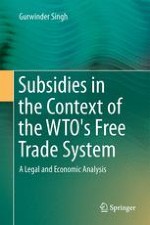Abstract
The discussion in this chapter continues from the previous chapters where the line of discussion follows that since the formation of the WTO, the international trade pattern has been progressing in the direction of free trade and has by and large been competitive and based on efficiency; nevertheless it is more beneficial to the multinationals. This has raised new forms of trade related issues that can be compared with benefits of several types, and one such is comparing the benefit obtained by multinationals, with the subsidies defined under the SCM Agreement.
As the present trend of trade between the Developed and Developing nations, in intermediate products is growing, so the legal requirement of the declaration of the nationality of the products and intermediate products is necessitated. Declaration of the nationality of the products will unfold the complexities involved whilst also strengthening the promotion of free trade. The declaration of the nationality of a product is the key feature of market transparency and at the procedural level, it also helps in applying the regulatory provisions. On the basis of these emerging concerns, it seems that the application of the “Rules of Origin” to determine the place of manufacture in the present day international trade is quite relevant. Furthermore, with regards to the trends in free trade, the manufacturing process of the products is no longer confined to one place or nation, but is becoming allocated to several countries. In today’s complex trading system, more and more products are being given a final shape by obtaining intermediate parts from other nations, wherever they can be cheaply manufactured or are available. The choice of the place for the manufacturing of intermediary products can often be discriminatory, as the priorities are to attain cost efficient products. From the market observation, it can be said that this newly-developed pattern of trade, based on different production places, demands a new approach in the legal analysis to uncover the production intricacies. The WTO, as a trade regulating institution, has thus included a Rules-of-Origin Agreement, so as to determine the place from which the product has actually originated or is being produced.
In this chapter, an attempt has also been made to analyse the adverse effect of applying the Agreement on Rules of Origin by the Member States.
What can then be seen, are the challenges to free trade because of the preference given to the products based on the Rules-of-Origin. With the proliferation of regional-trade agreements such as NAFTA, ASEAN, CAFTA and several others, the WTO Member States, some of which are also the members of these regional trade agreements, prefer trading among themselves by giving tariff preferences. An examination from this standpoint also covers the broader issue of trade subsidies in terms of financial contribution and benefit, which from the WTO perspective, is a form of tension between legal values and the economic compulsions associated with international trade.
Testing such obtained trade gains, within the limits of subsidies classified as prohibited or actionable subsidies in the SCM Agreement, for restricting the subsidies of exports, finally raises questions concerning the new forms of subsidies. The study in this chapter is to inquire about the unconventional form of trade benefits obtained by applying the Rules of Origin, as the features of such profits can be compared with subsidies.
